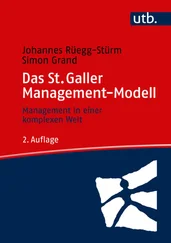Johannes Rüegg-Stürm - Managing in a Complex World
Здесь есть возможность читать онлайн «Johannes Rüegg-Stürm - Managing in a Complex World» — ознакомительный отрывок электронной книги совершенно бесплатно, а после прочтения отрывка купить полную версию. В некоторых случаях можно слушать аудио, скачать через торрент в формате fb2 и присутствует краткое содержание. Жанр: unrecognised, на немецком языке. Описание произведения, (предисловие) а так же отзывы посетителей доступны на портале библиотеки ЛибКат.
- Название:Managing in a Complex World
- Автор:
- Жанр:
- Год:неизвестен
- ISBN:нет данных
- Рейтинг книги:5 / 5. Голосов: 1
-
Избранное:Добавить в избранное
- Отзывы:
-
Ваша оценка:
- 100
- 1
- 2
- 3
- 4
- 5
Managing in a Complex World: краткое содержание, описание и аннотация
Предлагаем к чтению аннотацию, описание, краткое содержание или предисловие (зависит от того, что написал сам автор книги «Managing in a Complex World»). Если вы не нашли необходимую информацию о книге — напишите в комментариях, мы постараемся отыскать её.
Managing in a Complex World — читать онлайн ознакомительный отрывок
Ниже представлен текст книги, разбитый по страницам. Система сохранения места последней прочитанной страницы, позволяет с удобством читать онлайн бесплатно книгу «Managing in a Complex World», без необходимости каждый раз заново искать на чём Вы остановились. Поставьте закладку, и сможете в любой момент перейти на страницу, на которой закончили чтение.
Интервал:
Закладка:
We are grateful to the project team at Alltag (Gloria Weiss, Phillip Bührer, and Rachel Kühne), whose patience and creative inspiration have produced visual materials that works, as well as a neatly designed, aesthetically pleasing book. Finally, we wish to thank Matthias Haupt for being an excellent publisher.
We have co-authored this book from start to finish. The fact that our endeavor has borne fruit is not self-evident. It is not our achievement alone, but the result of a mixture of intellectual joy, trust, friendship and happiness, for which we are grateful.
St. Gallen, October 2019
Johannes Rüegg-Stürm & Simon Grand [7]
How best to approach this book
The St. Gallen Management Model (SGMM) is not simply a collection of conceptual frameworks. Instead, it presents two complementary perspectives on the interplay of environment, organization, and management in the form of an integrated model. Together, these interacting perspectives – the task perspective and the practice perspective – form the SGMM.
• The task perspective focuses on the two core tasks of management: first, to provide business-oriented analysis; second, to design organizational value creation. As such, this perspective also examines the analytical tools needed to perform these tasks.
• The practice perspective illuminates the fundamental cultural and communicative preconditions for management to achieve impact. We adopt this perspective to familiarize readers step-by-step with new ways of thinking about environment, organization, and management.
We are convinced that exploring innovative visions of the future and possibilities for action, and opening up to critical reflection what might otherwise be unquestioningly considered self-evident, requires developing new and thus unfamiliar forms of language and thought.
With this in mind, we hope that interested readers will approach this book unbiased. Working with the SGMM ought to serve two purposes: first, to generate new and helpful ways of thinking about management practice; second, to help deepen and reflect on these insights together with colleagues, perhaps also in connection with pursuing a degree or executive training in management. We hope, moreover, that the management practices established at a specific organization, as well as the associated challenges, may also become the subject of the kind of reflection suggested here.
We have provided several aids to support readers as they work through this book. The SGMM is structured according to a number of basic principles. Knowing these facilitates reading the book and working with the model. [9]
• Important definitions and terms are italicized (and thus highlighted). They can also easily be found in the subject index.
• The model categories of the SGMM are presented and explained in the introductions to the task perspective and the practice perspective. These two perspectives and their interplay become more understandable as readers become more familiar with the entire model. Conversely, a solid knowledge of the individual model categories promotes overall understanding of the model. Hence, we suggest that readers not only read through each chapter once, but also delve deeper into especially relevant sections.
• Understanding the model will depend on one’s own grappling with its components and thus on one’s willingness to constructively and critically illumine specific topics based on one’s own work context.
• Managers may use the SGMM to initiate fundamental processes of clarification and reflection, on the one hand in general conceptual terms and on the other in concrete design terms. The term “strategy” illustrates this particularly well:
– The term “strategy,” which we introduce as a model category in the SGMM’s task perspective, has manifold meanings in science and practice. Managers must clarify which aspects, phenomena, and facts of organizational reality the term “strategy” represents and should be used for in daily practice. Hence, one needs to fundamentally clarify the meaning of strategy in general and define how strategy ought to be understood. This serves to develop a common understanding of strategy as a general concept among managers. [10]
– On this basis, one needs to simultaneously clarify what a specific organization’s “strategy” consists of concretely. What is its core? How does it become visible? What is it meant to achieve? The SGMM’s practice perspective includes various considerations and forms of description. These facilitate precisely describing an established strategy in its complexity and “communitizing” its understanding by the responsible managers. This, in turn, is an important prerequisite for further developing a strategy, jointly and purposefully.
• In order to help our readers develop a good overall understanding of the SGMM, we have cross-referenced important topics, terms, and illustrations. The four main chapters are abbreviated as follows:
– Introduction: INT
– Task perspective: TPP
– Transition to the practice perspective: TRA
– Practice perspective: PPP
Chapter abbreviations are followed by a reference to the corresponding section. For example, chapter 5.4.1
(“Cultural understanding”) in the task perspective is cross-referenced as follows: (→ TPP, 5.4.1
).
In sum, the SGMM invites managers to work together with their teams on topics and challenges so as provide additional and novel scope for action and development with a view to advancing organizational value creation.
Saying that, the SGMM also invites teachers and students to experience, in a new way, the interplay of environment, organization, and management of organizations with which they may already be familiar, and to critically reflect on selected topics. Visit www.sgmm.chfor additional information and teaching materials. [11]
INTRODUCTION
1 Why is a detailed examination of management more important than ever?
The term “management” is ubiquitous nowadays. Nevertheless, what management really is, or rather what its core is, often remains vague. Thirty years ago, Hans Ulrich spoke of a “societal function that is not understood” (Ulrich, 1984). He thus highlighted that although management is highly important, not only economically but also societally, its importance is often not explicitly addressed. Second, he indicated that the core of management is actually far from obvious (Malik, 2013; Tsoukas, 1994; Watson, 1994). We consider this unsatisfactory. Not only because management is so omnipresent today but also because it is becoming increasingly important and demanding (Cunliffe, 2014; Mintzberg, 2009; Ulrich, 1984).
Here we mean the core purpose of management, which often remains undefined in business administration (Malik, 2013; Ulrich, 1984): to shape value creation through division of labor, as today’s organizations do in the form of products and services for specific value creation addressees (customers, citizens, patients, students, etc.). Such value creation is increasingly preconditioned. It depends on specific knowledge, complex integrated processes, elaborate technical expertise, and sophisticated physical and technological infrastructures. Often, value creation also involves a large variety of actors, who may perceive and evaluate the value of value creation very differently in its overall context.
The three examples below illustrate just how diverse and complex modern value creation is:
• Take a young biotech enterprise: Its basic value creation may lie in developing new medication for cardiovascular disorders. Central to this value creation are scientific findings on mechanisms of action in the human body, new R&D processes (e.g., from systems biology), and new technologies (e.g., digital simulation models). These are sometimes developed by the company itself, sometimes in partnerships with other startups and established corporations, and sometimes are also taken over from these. At the same time, it is important to attract the best employees in the relevant fields of knowledge and to secure the necessary financial resources in several funding rounds. The key tasks – structuring this complexity, setting the right priorities, and establishing robust partner relationships with different stakeholders – all require effective management practice. [20]
Читать дальшеИнтервал:
Закладка:
Похожие книги на «Managing in a Complex World»
Представляем Вашему вниманию похожие книги на «Managing in a Complex World» списком для выбора. Мы отобрали схожую по названию и смыслу литературу в надежде предоставить читателям больше вариантов отыскать новые, интересные, ещё непрочитанные произведения.
Обсуждение, отзывы о книге «Managing in a Complex World» и просто собственные мнения читателей. Оставьте ваши комментарии, напишите, что Вы думаете о произведении, его смысле или главных героях. Укажите что конкретно понравилось, а что нет, и почему Вы так считаете.










